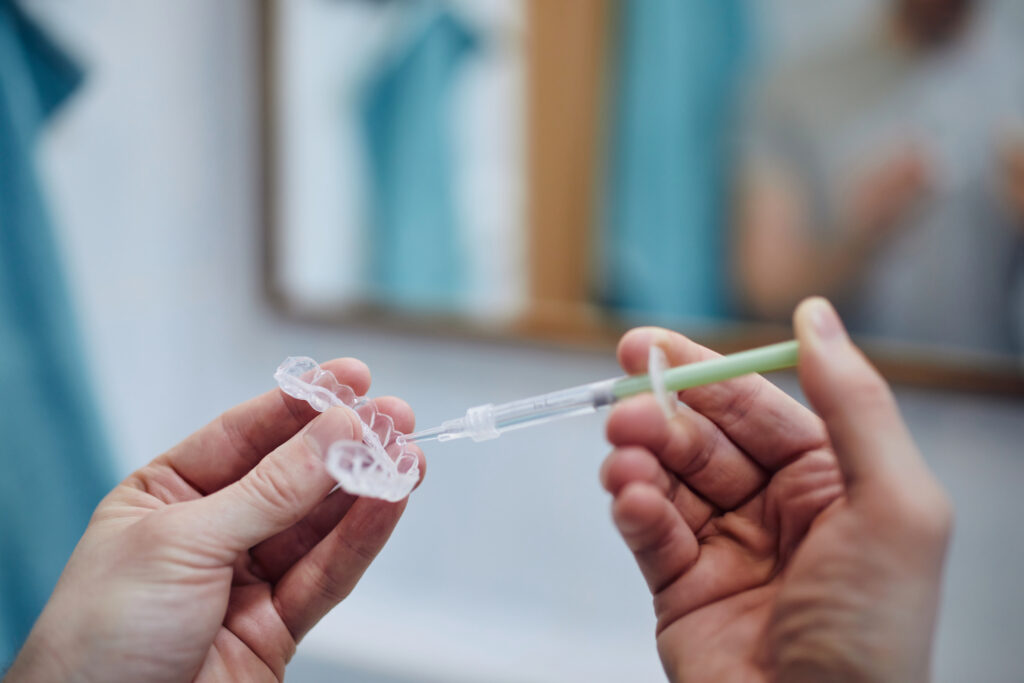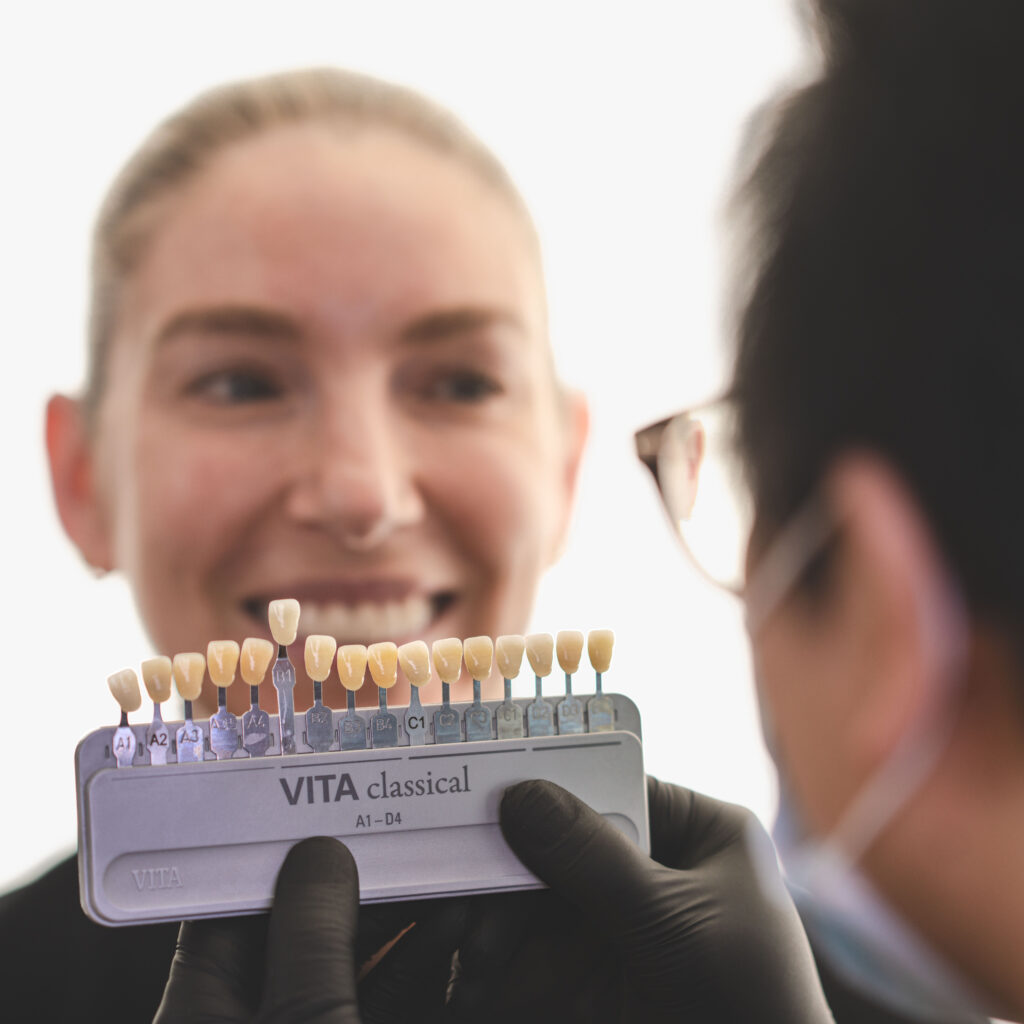Let’s explore some of the common questions about this popular cosmetic dental treatment.
What is teeth whitening?
Teeth whitening is a cosmetic dental procedure that lightens the natural shade of your teeth. The most common method uses bleaching agents, such as hydrogen peroxide or carbamide peroxide, to break down the molecules that cause discolouration. By penetrating the outer layer of the enamel, these agents can effectively lighten the tooth’s appearance by several shades.
Whitening treatments can address surface stains caused by foods, drinks, and lifestyle habits (like smoking) as well as some deeper discolouration.
However, it’s important to note that the procedure will not result in a perfect white shade, but it can significantly brighten your teeth depending on your original colour.
How is teeth whitening done?
Teeth whitening treatments are typically carried out in two main ways: professional in-chair whitening and at-home kits provided by a dentist.
In-chair whitening involves a more concentrated whitening solution and often uses a light or laser to activate the whitening agent. This process allows for faster and more noticeable results, often within one-two sessions. The dentist will protect your gums and other soft tissues before applying the whitening gel, ensuring safe and effective treatment.

At-home whitening kits provided by a dentist offer a more gradual approach. The dentist creates custom-fitted trays for your teeth and provides a lower-concentration whitening gel. You will wear these trays for a set amount of time each day over a period of weeks. While this method takes longer than in-chair whitening, it can still achieve excellent results under the guidance of your dentist.

Is teeth whitening suitable for everyone?
While many people can benefit from teeth whitening, it’s not suitable for everyone. For instance, people with dental restorations like crowns, veneers, or fillings in visible areas should be aware that these materials do not respond to whitening agents. Additionally, people with gum disease, extremely sensitive teeth, or enamel issues may not be ideal candidates for whitening.
A consultation with your dentist is essential before starting any whitening treatment. They can assess your oral health and recommend the best approach based on your needs.
Is teeth whitening permanent?
Teeth whitening is not a permanent solution. The effects can last anywhere from a few months to a few years, depending on your habits.
If you smoke or regularly consume staining foods and drinks like red wine, coffee, or tea, your teeth may begin to discolour again sooner. Regular touch-up treatments or using at-home kits can help maintain your results.

Are there risks involved with teeth whitening?
When performed under the supervision of a qualified dentist, teeth whitening is generally safe. However, some people may experience temporary tooth sensitivity or gum irritation after treatment. These side effects usually subside within a few days.
It’s important to avoid non-professional whitening services, such as those offered at beauty salons or through unverified online kits, as these can increase the risk of damage to your enamel or gums.
Always consult with a dental professional to ensure you’re receiving safe and effective treatment.

Can teeth whitening address all types of stains?
Teeth whitening works best on surface stains, which are typically caused by food, drinks, or tobacco. However, it’s less effective on intrinsic stains, which are deeper within the tooth structure and can result from factors like medication use or trauma.
In cases where teeth whitening may not be effective, your dentist may recommend alternatives like porcelain veneers to achieve a brighter, more even smile.
Are at-home whitening kits effective?
Over-the-counter whitening kits, strips, and toothpastes are widely available, but they usually contain lower concentrations of bleaching agents than professional treatments.
While they can provide some improvement, the results are often less dramatic and take longer to achieve.
Additionally, using these products without proper guidance can sometimes lead to uneven results or gum irritation.
For best results, it’s recommended to work with your dentist to develop a customised whitening plan tailored to your specific needs.
Will teeth whitening work for you?
Teeth whitening can make a huge difference, but it’s important to have realistic expectations.
While professional whitening can significantly improve the brightness of your teeth, it won’t change their natural shape or address deeper intrinsic stains.
If you have more complex cosmetic concerns, such as chips, gaps, or severe discolouration, your dentist may suggest options like porcelain veneers or full mouth reconstruction to achieve your desired results.
During your consultation, your dentist will evaluate your oral health and discuss which options are best suited to you.

Why choose professional teeth whitening?
Professional teeth whitening offers several advantages over at-home or non-dental alternatives:
- Customisation: Your dentist will tailor the treatment to your teeth’s specific needs, ensuring optimal results while minimising discomfort or sensitivity.
- Safety: Dentists use proven techniques and safe concentrations of whitening agents, and they protect your gums and soft tissues during the process, reducing the risk of irritation.
- Faster results: In-chair whitening can deliver dramatic improvements in just one visit, compared to the slower progress of over-the-counter kits.
- Longer-lasting outcomes: Professional treatments are more effective and can maintain a brighter smile for longer periods with proper aftercare.
Ready for a brighter smile?
If you’re considering teeth whitening, it’s important to speak with a dental professional to ensure it’s the right choice for you.
At Advanced Dental Artistry, we’re all about the big picture. Our approach to treatment focuses on your overall health, function, and long-term smile goals—not just quick fixes. That’s why we don’t offer teeth whitening on its own. Instead, we include it as part of a complete treatment plan, like when you’re getting porcelain veneers or a full mouth reconstruction. This way, you get a beautifully cohesive, lasting result.
Book a consultation with us today to explore the best options for enhancing your smile and achieving your aesthetic goals.

